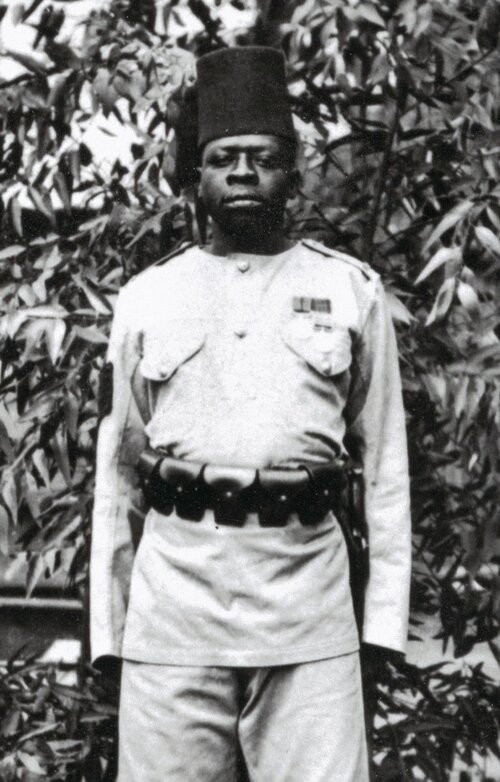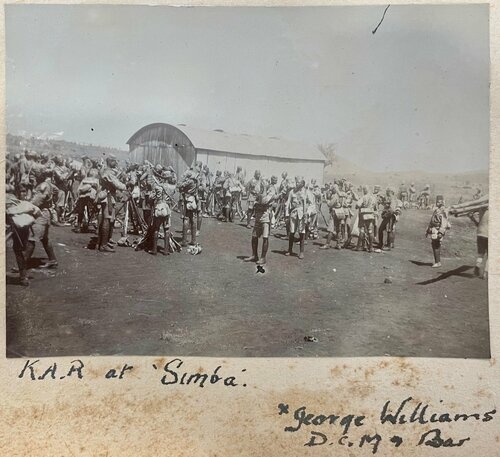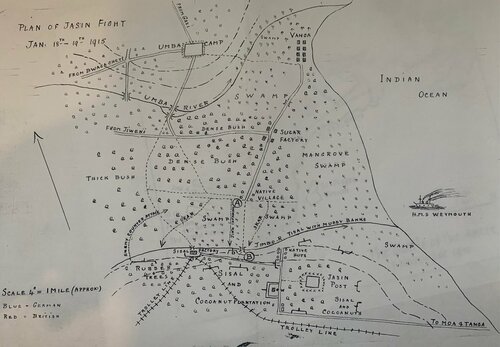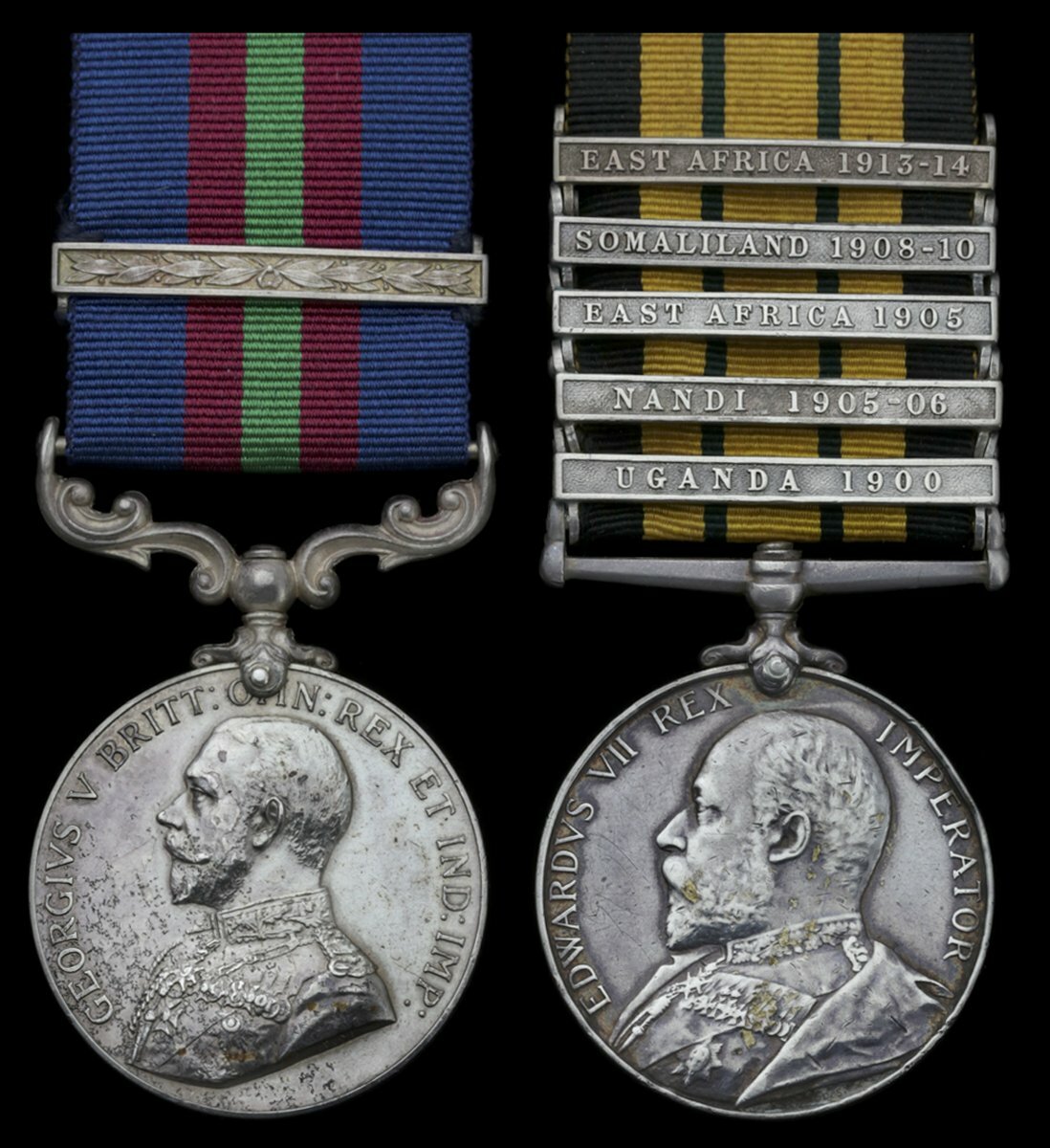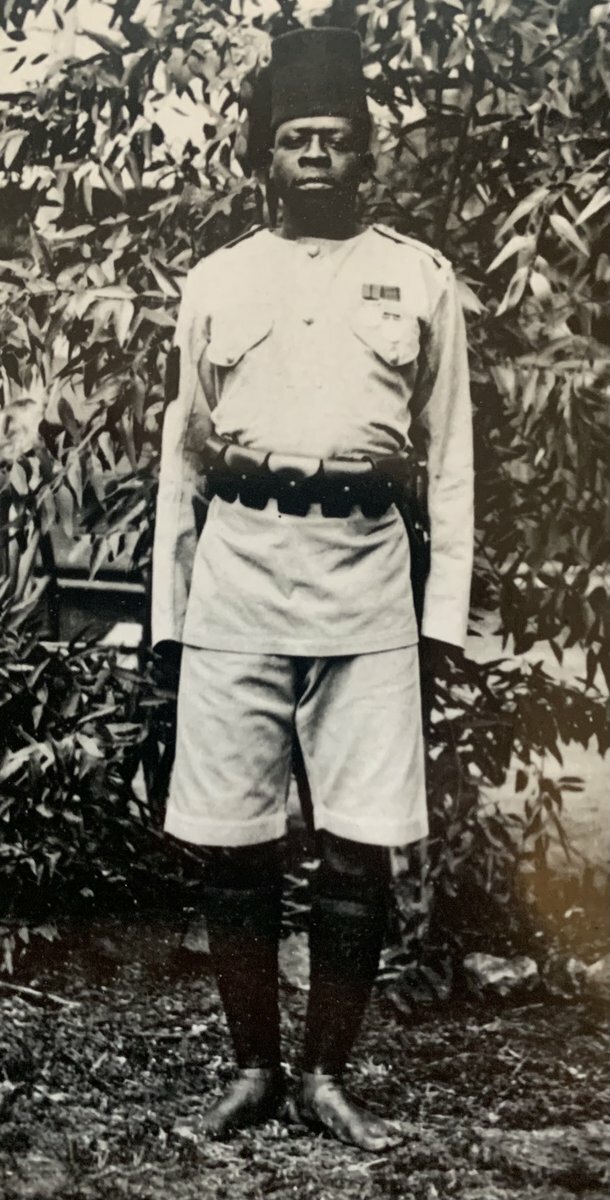Auction: 21003 - Orders, Decorations and Medals
Lot: 502
'I would urge for consideration whether this N.C.O. should not now be considered worthy of receiving the VICTORIA CROSS, this being the fourth time his name has been brought to notice for conspicuous acts of gallantry in twelve months.'
Letter to the War Office, 1915.
The important King's African Rifles D.C.M. and Bar pair awarded to Colour-Sergeant G. Williams, 3rd King's African Rifles, decorated for his gallantry at Tsavo in October 1914 and latterly recommended for the Victoria Cross for a further act of bravery at Jassin in January 1915; Williams would be killed in action in July 1918
King's African Rifles Distinguished Conduct Medal, G.V.R., with Second Award Bar (1925 C.Sjt: George Williams. 3/K.A.R.); Africa General Service 1902-56, 5 clasps, Uganda 1900, Nandi 1905-06, East Africa 1905, Somaliland 1908-10, East Africa 1913-14 (687 Pte. George Williams. Uganda Rifles.), claw a little loose on this last and with attempted erasure of naming, thus a little weak in one or two places, A.G.S. nearly very fine, the D.C.M. better (2)
Recommendation for the Victoria Cross, to the War Office:
'Commanded 'D' Company on the 18th January after Lieutenant Dean had been wounded and the Effendi killed. He succeeded in extricating the Company after all the ammunition had been expended, and went back by himself under very heavy rifle and machine gun fire and brought in a maxim gun.
This N.C.O. has earned a great reputation for gallantry. He was promoted Sergeant from Lance-Corporal for gallantry at Adalile on 15 December 1913 (Maheran Country).
He was granted the Distinguished Conduct Medal for gallantry in action as Tsavo on the night of 5/6 September 1914. Promoted Colour-Sergeant for gallantry in the field at Tsavo on 1 October 1914.
I would urge for consideration whether this N.C.O. should not now be considered worthy of receiving the VICTORIA CROSS, this being the fourth time his name has been brought to notice for conspicuous acts of gallantry in twelve months.'
King’s African Rifles D.C.M. through K.A.R. orders and published in The Times 11 May 1917::
'For showing great courage and enterprise on the night of 5-6 September 1914, at the action at Tsavo. This N.C.O. twice, at great personal risk, crept up to the German position and brought back information of the enemy’s disposition and strength.’
George Williams first saw active service with the Uganda Rifles against the Nandi in Uganda from July-October 1900 (Medal & clasp), before gaining further clasps for Nandi 1905-06, East Africa 1905, Somaliland 1908-10 and finally the clasp East Africa 1913-14 for actions against the Marehan, during which Williams was promoted Sergeant.
Lloyd Jones in K.A.R. gives further detail:
‘Occasionally half-educated Swahilis ejected from the missions in Zanzibar presented themselves for enrolment, and were eagerly snapped up, as owing to their knowledge of a smattering of English they were invaluable as clerks and signallers. As can easily be imagined, these ex-mission boys were often characters, and many amusing stories are current concerning their bold if amusing efforts to express themselves on paper. Usually adorned by such uncompromising English Christian names as George Williams or John Dixon, they would frequently voice remarkably oriental and eminently pagan sentiments when trying to express themselves in the language of their adopted faith.
George Williams, though nominally a Christian, made no pretence of piety, but freely admitted that he still feared the “devil” and other malignant spirits which had been a terror to his ancestors. He was an excellent signaller, and a capable Sergeant, though his occasional relapses resulted in his reduction to the ranks more than once. He always bobbed up again, and on several occasions he distinguished himself on service.’
Williams wrote to Lloyd-Jones:
'Dear Sir, Just I receive news that you have been fighting with the Habashi and you get wounded...this country now we are fighting with Marehan. The first time, I went to Adalile Hill to working, as you know signalling station with three signallers and escort of 7 men. I have to start working from 15 November 1913.'
Having shown gallantry on two occasions at Tsavo, Williams showed further gallantry of the most inspiring nature at Jassin in January 1915, when the German accounts offer:
'A strong British force was beaten in a two-day battle on January 18th-19th near Jassin. The British lost some 200 killed. Four Companies were captured. The total losses of the British were about 700 men, 350 rifles, one machine-gun and 60,000 rounds of ammunition.'
Williams himself shone once again in the action, going back under a heavy fire to drag out the machine gun under his command, after the whole crew and porters had been killed. Making his way through the bush with the 60-pound weapon, he was even noted as having apologised for not having come back to camp with its tripod (WO106/273, refers). After the initial recommendation went into the War Office in February 1915, a catalogue of administrative errors and misinterpretations took place. The thread is attempted to be explained below. Mr Machtig of the Colonial Office wrote on Valentine's Day 1916:
'This is rather a curious point the Victoria Cross Warrant of 1856 laid down that the distinction was applicable to our Army and Navy. Of course, in those days there was no KAR but it was clearly intended that the (Victoria) Cross, should only be given to members of the British Army and Navy. Proof of this is to be found in the fact that a special warrant was issued extending the application to persons, who may hereafter be employed in the local forces raised, or which may be raised in our Colonies and their dependencies and who may be called upon to serve in co-operation with our troops in military operations.'
He continued:
'Clearly if we are to claim that native soldiers of the KAR are eligible. We must take our stand upon the terms of the 1867 warrant. But in view of the definite extension in 1911 to the Indians, it would seem difficult to do so.'
Referencing the KAR Regulations which explicitly mention the Victoria Cross and the Askari:
'Any native officer, NCO or private being in possession of the Victoria Cross…..shall be exempted from paying Hut Tax. Sergeant George Williams in whose case the point has now come up was recommended for the V.C. by General Tighe (document number WO38244) He has already been given the KAR Distinguished Conduct medal for a previous act of gallantry.'
Furthermore, the letter of March 1916 continued:
'HM The King (George V) has decided that the warrant of 1867 covers the case of all Native troops forming part of the Dominions or Colonial Forces no matter what colour or race they may be (sic).
The letter from the War Office is also retained in the file, reference 012/2510/ (M.S.3): the question is then raised as to where this leaves the recommendations of Colour Sergeant George Williams's 3rd Battalion KAR for the Victoria Cross?'
Further confusion is thrown into the mix as it appears the fact that the fact that Major-General Tinghe had been awarding Medals to his Division without the consent of the Secretary of State for the Colonies had touched a nerve. In his letter of 30 June 1915 he had approved the award of a number of King's African Rifles Distinguished Conduct Medals direct to the War Office to be promulgated in the London Gazette, with the matter of William's Victoria Cross placed in the attachment:
'Also recommended for a Victoria Cross by my No. 242 dated 1st March 1915; if the VC has not been granted, recommend for an additional Bar (to the KAR DCM). No. 1925 Colour Sergeant George Williams DCM 3/KAR.'
The issues thus stemmed from the poor communication and historical reluctance for smooth business between the War Office and the Colonial Office. The politics between the two Offices, besides the fact their GOC's were unclear to whom the recommendation for awards should be passed, made the case even more difficult. Whilst it meant the case of Williams was seemingly overlooked for the time, Clause 7 of the Victoria Cross actually conferred the ability for the bypassing of the authorities:
'If the act in question be performed under the eye of the Officer Commanding the forces in the Field or the General commanding a division of a General commanding a brigade, such a General Officer shall have the power of conferring the decoration on the spot, subject to confirmation of the Sovereign.'
In order that all awards were to come to the Colonial Office in future, of which a telegram of 14 September 1915 relates:
'To the General Officer Commanding in Nairobi, East Africa, your action in conferring African Distinguished Conduct Medal is irregular. (Stop) No further awards to be made by you, but recommendations may be submitted direct to the Colonial Office with which department authority rests. Military Secretary.'
Despite the fact the Victoria Cross which Williams surely earned, the Bar to the D.C.M. had already been published in the Colonial Office Official Gazette of 22 December 1915, General Notice No. 909. He was killed in action in Portuguese East Africa in the first days of July 1918, as recalled by Colonel T. O. Fitzgerald:
'During this period of the campaign some very severe fighting took place particularly at Namurie where the 3rd/3rd KAR was again badly handled losing a considerable number of officers and men. At Namacurra, near Quilimane, close to the Zambesu River, where a detachment of the 2nd /3rd KAR was operating with the Portuguese. Most of the men were either killed or drowned in this action in attempting to cross the Namacurra, a river infested with crocodiles. Major Gore-Brown, a very gallant officer who was commanding the detachment, also lost his life attempting to swim the river. Company Sergeant George Williams, who did such very gallant action throughout the campaign, was killed in action.'
Williams would not have been issued any Campaign Medals for the Great War and none have been traced; sold together with a comprehensive file of copied research, including a photograph of Williams proudly wearing his two Medals.
Subject to 20% VAT on Buyer’s Premium. For more information please view Terms and Conditions for Buyers.
Sold for
£11,000
Starting price
£3200


